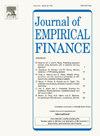Forecasting financial volatility: An approach based on Parkinson volatility measure with long memory stochastic range model
IF 2.4
2区 经济学
Q2 BUSINESS, FINANCE
引用次数: 0
Abstract
This paper proposes a long memory stochastic range (LMSR) model to investigate the persistence of range-based volatility series. The latent variable in the LMSR model is derived from the established autoregressive fractionally integrated moving average process. To estimate the model parameters, there is no closed-form solution for the latent process. Hence, the parameters of the stochastic model are estimated by applying the quasi-maximum likelihood method via the Whittle approximation. A comprehensive simulation study assesses the method’s performance, with results showing that estimated parameters are close to true values and precision improves with longer simulated time series lengths. To demonstrate the applicability of the model, we conducted empirical studies based on four financial assets, and their volatilities are estimated directly using the range-based Parkinson (PK) volatility measure. The results show evidence of long memory in these volatility series using the rescaled range and Geweke-Porter-Hudak methods. We fit the resulting PK volatility estimates to the LMSR model and other competing volatility models, and their modelling performances are compared. Results indicate that all LMSR models outperform competitors according to the log-likelihood and Akaike information criterion as well as out-of-sample loss functions. Additionally, the estimated parameters of these LMSR models confirm the presence of long memory, while competing short memory models struggle to capture the persistent nature of volatility in financial markets.
金融波动预测:基于长记忆随机区间模型的帕金森波动测度方法
本文提出了一个长记忆随机极差(LMSR)模型来研究基于极差的波动率序列的持久性。LMSR模型的潜变量来源于已建立的自回归分数积分移动平均过程。为了估计模型参数,隐过程没有封闭解。因此,采用拟极大似然方法通过惠特尔近似估计随机模型的参数。综合仿真研究评估了该方法的性能,结果表明估计参数接近真实值,并且随着模拟时间序列长度的增加,精度有所提高。为了证明模型的适用性,我们基于四种金融资产进行了实证研究,并使用基于区间的帕金森(PK)波动率测度直接估计了它们的波动率。使用重新标度的范围和Geweke-Porter-Hudak方法,结果显示这些波动率序列具有长记忆的证据。我们将得到的PK波动率估计拟合到LMSR模型和其他竞争波动率模型中,并比较了它们的建模性能。结果表明,根据对数似然和赤池信息准则以及样本外损失函数,所有LMSR模型都优于竞争对手。此外,这些LMSR模型的估计参数证实了长记忆的存在,而竞争的短记忆模型难以捕捉金融市场波动的持久性。
本文章由计算机程序翻译,如有差异,请以英文原文为准。
求助全文
约1分钟内获得全文
求助全文
来源期刊

Journal of Empirical Finance
Multiple-
CiteScore
3.40
自引率
3.80%
发文量
59
期刊介绍:
The Journal of Empirical Finance is a financial economics journal whose aim is to publish high quality articles in empirical finance. Empirical finance is interpreted broadly to include any type of empirical work in financial economics, financial econometrics, and also theoretical work with clear empirical implications, even when there is no empirical analysis. The Journal welcomes articles in all fields of finance, such as asset pricing, corporate finance, financial econometrics, banking, international finance, microstructure, behavioural finance, etc. The Editorial Team is willing to take risks on innovative research, controversial papers, and unusual approaches. We are also particularly interested in work produced by young scholars. The composition of the editorial board reflects such goals.
 求助内容:
求助内容: 应助结果提醒方式:
应助结果提醒方式:


